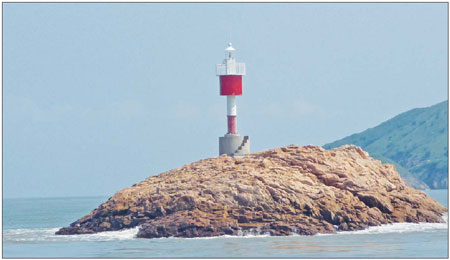Top News
Island getaway may be a costly dream
Updated: 2011-04-29 11:35
By Shi Yingying (China Daily European Weekly)
 |
|
Wuzhizhou Island Resort Center is one of the successful island developments in Sanya, Hainan province. It took more than 15 years and 200 million yuan for the developer to make it into a tourist attraction. Provided to China Daily |
Uninhabited havens up for lease but potential customers face wave of challenges in developing them
Ni Dingkang opens Google Earth and browses 1,390 islands scattered around Zhoushan, the only prefecture-level city in China made up solely of islands, in Zhejiang province. He locates the 10 chosen ones. These are the uninhabited islands that Zhoushan is willing and ready to lease to private citizens and companies. They are among 176 unoccupied islands, off the coast of eight provinces, that have the potential to become private islands.
But do not grab your hammock and flip-flops quite yet.
The policies governing leases of the islands are not complete. Local governments will not pay to equip the islands with fresh water, electricity, roads or docks. Those tasks fall to whoever qualifies for the lease. And whatever financial terms are reached, that is just the beginning of the spending cycle.
Since the State Oceanic Administration released the list of 176 islands on April 12, Ni has been busy fielding telephone calls and visits from eager investors. "No, you cannot buy the island and do whatever you want," he tells them.
Ni works in the maritime space office of the Zhoushan ocean and fisheries bureau and is familiar with the islands. He is the one responsible for fielding the inquiries and looking for good potential renters. By "good" he means "the ones with long-term development plans and environmental concerns in mind", not just "those who only offer an attractive price".
It is much harder to locate the perfect candidate than he expected. Many of the potential investors are thinking along the lines of: "Can I connect the unoccupied island to the nearby big one and make it the dock for my shipyard in the future?"
"But they can't," Ni says, "because the functions of these 10 islands are fixed, or at least have fixed uses, such as for tourism, commercial fishing or public services.
 |
"For example, five of them with better geographical locations, which means they're nearer the mainland, are going to become tourist resorts. Three of the relatively smaller ones, including two with areas less than 500 square meters, are going to become the bridge piers to reduce the local government's budget for building cross-sea bridges in the future.
"On top of that, they're not allowed to make serious alterations to the island's physical features," he says.
Piles of paperwork
In addition to potential investors with "the wrong plan", Ni says, "most of the rest are scared off by the complicated application process".
China's Island Protection Law, which took effect in March 2010, says that individuals may use an uninhabited island for five to 50 years after obtaining approval from both the government and ecologists.
Ni gives some details for this region: "They have to prepare detailed island development plans for the next five years and other associated documents, and go through us (Zhoushan ocean and fisheries bureau), Zhejiang Ocean and Fisheries Bureau, State Oceanic Administration and the State Council.
"Many investors gave up after I explained all of this to them."
In addition, Liu Zhigang, vice-director of Zhoushan ocean and fisheries bureau, says: "So far there's no complete approval criteria even after they hand in the application. I was told it would come out by the end of the year at the earliest."
The first batch of uninhabited islands lists 176 off Zhejiang, Fujian, Hainan, Guangdong, Jiangsu, Shandong and Liaoning provinces as well as the Guangxi Zhuang autonomous region. There is no shortage of islands that could be available for future lists. This list names 31 from Zhejiang alone - 31 out of the province's 2,878 islands that measure 500 to 1,000 square meters. Ninety percent of them are unoccupied.
"Being the first batch means they are located relatively close to the mainland and are more suitable for reclamation," says an official with the Zhejiang Ocean and Fisheries Bureau, who would not give her name. She says the 176 islands vary in size from more than 8 million square meters to less than 500. Most of them are about the size of a soccer field.
Calculations for the rent, she says, will take into account the island's size, the potential method for developing the land, its use and its distance from the mainland. Rent could run as high as 240,000 yuan (25,100 euros) a hectare a year (24 yuan a square meter a year) or as low as 14 yuan a hectare a year. That is a range of nearly 25,100 euros to 1.5 euros per hectare annually.
 |
|
One of the 1,390 islands of Zhoushan, the only city in China that consists solely of islands. Provided to China Daily |
It is not easy
Ding Feng has a few things to say to potential investors. He is vice-general manager of the Sanya Wuzhizhou Island Resort Center, which is on a 1.48-million-square-meter island off Sanya in South China's Hainan province. He has spent more than 15 years and more than 200 million yuan on Wuzhizhou Island, so he is qualified.
Today, he says: "You see visitors diving, sailing, riding water motorcycles and playing beach volleyball on an island lined with coconut palms along sandy beaches. But when we first came here in 1995, there was nothing - no people, fresh water, electricity, dock, road, nothing but more than 2,000 kinds of plants."
Attracted by these 2,000 plants and the island's location, less than 6 km from Sanya, the company started its first island investment with 100 million yuan in registered capital.
It took Ding several years to realize the amount needed to be doubled.
 |
"Everything was tougher than we expected, and the worst thing is we had no one to learn from. At the very beginning, it cost more to transport a bag of sand to the island than buy one. Practical problems were everywhere.
"For example, we thought one dock would be enough - until we figured the island had southwester storms for half a year and northeasters for the other half. Ships heaving in one dock wouldn't be safe for the whole year, so the budget for dock-building had to be doubled. Now we've got two docks on opposite directions of the island."
Things like this aren't in a textbook or anyone's experience, at least in China, Ding says. His company went through a few general managers before the company started to make money. Ding says the island finally broke even three years ago.
The company even thought about giving up in 1999 because of Hainan's poor economy then. "Nobody was willing to take the island when we put it in the market and, to be honest, that's the only reason we still have it now," Ding says.
"Island tourism has become popular only in recent years, especially after the local government became interested in developing Haitang Bay, where our island is." He says construction is about to begin on a five-star hotel costing 6.8 billion yuan. "Now many investors want to take the island, but now we wouldn't sell it."
Despite the resort Ding's company developed and the luxury hotel that's on tap, Wuzhizhou Island is on the list of 176 available islands, along with four others that Sanya wants to develop further. The island has received 3.2 million visitors since it opened to the public in 1998.
Why resources matter
"Developing an unoccupied island is like building a small society," Ding says. "It's not at all about you, the investor, taking an empty island with no residents, but about taking everything into consideration." Environmental protection is a big part of that.
Ding says his company put its waste into a landfill the first year, then switched to incineration, bringing oil engines and other equipment onto the island. "Incineration, however, still has the risk of causing a forest fire, so we stopped using it and now carry whatever has been brought to the island off the island.
"Restrictions on how many tourists can land on the island have been made as well," he says, "and our current limit is 3,000 per day." Those kinds of practices recognize that the island's natural resources are key draws to tourists, Ding says.
Island development is more attractive now than it was 15 years ago, Ding says, but the barriers to doing it are higher. It is certainly more complicated and more expensive.
"You have to be patient enough and have a fat wallet. Plans for both the island's short-term infrastructure and a long-term blueprint need to be prepared. And most important," he says, "pick the right island."
'Gone in seconds'
Not everyone is confident the offer of 176 islands will attract hordes of investors. Tang Hongsen, a professor at Zhejiang Ocean University, hears an echo of 2003, when the State Oceanic Administration for the first time allowed individuals and organizations to exploit such opportunities.
"But the moves did not gather momentum, as developers realized the enormous transportation costs for the construction material needed to develop the island," Tang says. "It's also costly to equip the islands with electricity and clean water."
Chen Xiaoxian, 35, could not agree more. A native of Wenzhou, she was the first in the area to rent the 80,000 square meters of nearby Zhuyu Island seven years ago.
"It was definitely much more difficult than I expected. My investment of over 1 million yuan was like water absorbed by the sands in the desert, gone in seconds."
She says she spent "more than 100 yuan to transport one cubic meter of sand to the island. Most of the money went for developing wharf facilities, electricity and clean water supplies, roads and environmental protection."
There was no Island Protection Law in China when Chen signed the five-year rental contract with the local government in 2004. "I only needed to pay a small amount of rent each year - something like 30,000 to 40,000 yuan - when both the local government and I reached an agreement that our bottom line was to take extra care of the environment."
Chen says it cost more than 200,000 yuan in 2007 alone to bring in seashells. "The idea was to build a sustainable resort and attract high-end tourists, but it turned out we didn't earn a penny at all."
The contract expired in 2009 and the island has been returned to the government. When asked whether she would invest in the island again after the release of the new list, Chen hesitates.
"It all depends on the details of the policy. You know you still have opportunities there. I know there's a luxury yacht club nearby and I've got all these years of experience of running an island."
E-paper

Head on
Chinese household care goods producers eye big cities, once stronghold of multinational players
Carving out a spot
Back onto center stage
The Chinese recipe
Specials

British Royal Wedding
Full coverage of the royal wedding of Prince William and Kate Middleton in London. Best wishes

The final frontier
Xinjiang is a mysterious land of extremes that never falls to fascinate.

Bridging the gap
Tsinghua University attracts a cohort of foreign students wanting to come to China.
